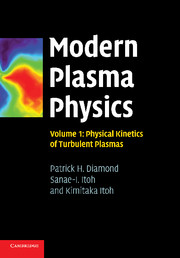Book contents
- Frontmatter
- Contents
- Preface
- Acknowledgements
- 1 Introduction
- 2 Conceptual foundations
- 3 Quasi-linear theory
- 4 Nonlinear wave–particle interaction
- 5 Kinetics of nonlinear wave–wave interaction
- 6 Closure theory
- 7 Disparate scale interactions
- 8 Cascades, structures and transport in phase space turbulence
- 9 MHD turbulence
- Appendix 1 Charney–Hasegawa–Mima equation
- Appendix 2 Nomenclature
- References
- Index
Appendix 1 - Charney–Hasegawa–Mima equation
Published online by Cambridge University Press: 05 October 2010
- Frontmatter
- Contents
- Preface
- Acknowledgements
- 1 Introduction
- 2 Conceptual foundations
- 3 Quasi-linear theory
- 4 Nonlinear wave–particle interaction
- 5 Kinetics of nonlinear wave–wave interaction
- 6 Closure theory
- 7 Disparate scale interactions
- 8 Cascades, structures and transport in phase space turbulence
- 9 MHD turbulence
- Appendix 1 Charney–Hasegawa–Mima equation
- Appendix 2 Nomenclature
- References
- Index
Summary
Drift waves and their nonlinear interactions are one of the most fundamental elementary processes in magnetized inhomogeneous plasmas. The simplest model equation that includes a fundamental nonlinear process is known as the Charney–Hasegara–Mima equation. The analysis of this model equation appears repeatedly in the text, in various contexts of plasma turbulence. The key feature of the equation is illustrated here.
Among various nonlinear interaction mechanisms, the advective nonlinearity (Lagrange nonlinearity) associated with E × B motion plays a fundamental role in drift wave dynamics. This nonlinearity appears in the fluid description as well as in the Vlasov description of plasmas. In the latter formalism, a large number of degrees of freedom is kept (as a velocity distribution), while the wave nonlinearity is possibly studied without considering this degree of freedom. An elementary nonlinearity associated with drift waves can be studied by use of fluid models.
Model
The simplest model equation is constructed for the inhomogenous slab plasma, which is magnetized by a strong magnetic field in the z-direction, and the density has a gradient in the x-direction, the scale length of which is given by Ln (Figure A1). Plasma temperature is constant, and temperature perturbation is not considered. Ion temperature is assumed to be much smaller than that of electrons.
- Type
- Chapter
- Information
- Modern Plasma Physics , pp. 385 - 397Publisher: Cambridge University PressPrint publication year: 2010



